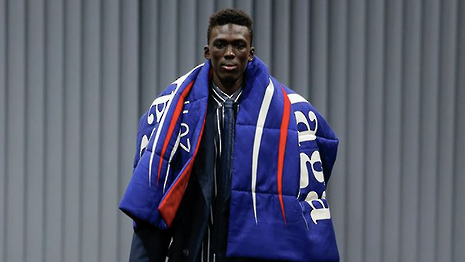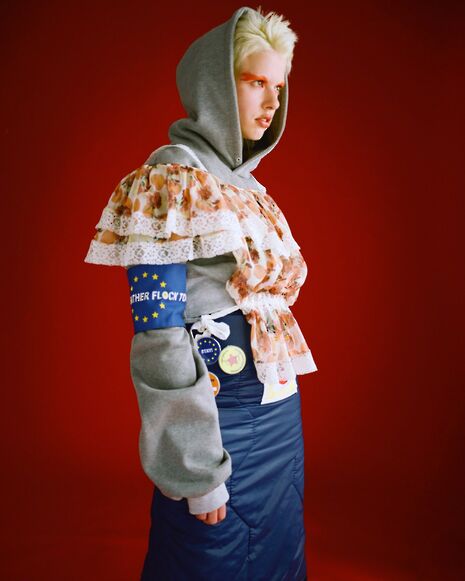Feeling the Bern at Balenciaga
Archie Squire discusses the potential for fashion to be used as a proactive political force

Clicking through last week’s Balenciaga Autumn-Winter 2017 menswear collection, it’s evident that political tropes have gained newfound visibility in the fashion mainstream. Creative director Demna Gvasalia, originally of Vetements, swapped the ‘Bernie’ of Bernie Sanders’ presidential campaign logo for the name of the fashion house that, until recently, had been flailing under the disastrous directorship of Alexander Wang. Without a doubt, Gvasalia has been doing infinitely better than Wang, and seems to have arrived effortlessly at the fundamental formula of desirable and commercially viable product which still offers something new (read: is indebted to Margiela in some way, shape, or form). But what does Balenciaga’s appropriation of the Sanders logo across clothing mean at the end of the day? Does it serve to dilute the seriousness of politics? Does it align Balenciaga with a liberal figure and hereby alienate the brand from that inevitable clump of its clientele that voted for Trump? Politics changes fast, just like fashion: who knows what will have happened by the time this collection actually reaches stores in late summer?

The relationship between fashion and politics is already somewhat oversaturated with critical and scholarly attention. Walter Benjamin introduced the notion of the “aestheticisation of politics” in the 1930s, alluding not only to the symbolism of Nazi parades and banners, but to the regime’s uniforms designed by Hugo Boss. Fast-forward to early January, and Trump’s tweets about meetings with the editor-in-chief of US Vogue, Anna Wintour, are an eerie echo. In this light, it is undeniably refreshing to see a house like Balenciaga turning its attention to Bernie Sanders, particularly after other brands have come out in public support of Trump (what happened to everyone burning their New Balance, people?). After all, Gvasalia is not staking Sanders for the coolness of his style, but for that of his politics.
Is this the only thing Gvasalia has done with the collection, though? Perhaps in an industry that consumes the beauty of youth faster than Trump’s team can think up newsworthy lies, what is equally political is Balenciaga’s casting. At least 3 of the 39 models appeared to be comfortably older than 45, and a fair few others defied the conventions of fashion-world attractiveness. 2016 was the year that transgender model Hari Nef appeared on the cover of four magazines, including ELLE UK’s September issue, and the flourishing notion of the ‘interesting’ has gradually shifted some attention away from ‘those interesting clothes’ to ‘that model’s interesting face’.
In addition, the collection featured sweatshirts emblazoned with the logo of the brand’s parent company, Kering, which also controls Gucci and Saint Laurent, among other houses. In a world of growing intolerance for corporations, attempts are often made to quash the visibility of corporate forces. Instagram hardly shouts about its Facebook ownership, and in fashion, financial support is something of a taboo subject with utterly visionary designers often living hand-to-collection (the now-defunct Meadham Kirchhoff, for instance) while the favoured few are nestled in a cosy financial crutch. Gvasalia does the opposite: the Reichstag of the fashion industry, he exposes the politics of luxury goods and their enslavement by the stock market. The Balenciaga set, too, was something of a return to David Brent’s nauseatingly bland office building in the BBC sitcom, packaged in nostalgia for late-1990s/early-2000s Postmodernism and its spatial moulding of corporate identity.
“Gvasalia does the opposite: the Reichstag of the fashion industry, he exposes the politics of luxury goods and their enslavement by the stock market.”
What relationship does all this bear to Bernie Sanders? Gvasalia sends out a Bernie-aga shawl, worn across the shoulders, as a flag bearing hope in the corporate landscape so despised by Sanders himself. Yet he simultaneously acknowledges the trappings of the bureaucratic system he now finds himself in at the helm of Balenciaga, the juxtaposition of Bernie-aga and Kering logos testifying to the contradictions in Gvasalia’s own allegiance. The aesthetics of casually disaffected youth that Raf Simons built his brand around from the mid-1990s are no longer the most effective way forward, and he recognises the need to be bold instead, as designer Philip Ellis was also keen to emphasise in his 2016 Central Saint Martins graduate collection that centred on Brexit and featured a handbag delivering the declaration “TORIES PUT THE ‘N’ IN CUTS”.
What does it actually mean to wear a ‘Sanders’ shawl or sweatshirt, however? Have we really reduced politics to pageantry? No: with Trump, it is evident that politics has done this by itself, or as Adam Curtis claims in his 2016 documentary, HyperNormalisation, that the financial systems have achieved this in reducing politicians to puppets. Gvasalia is piggybacking on the popularity of an ideology, but if this ultimately brings new attention to Sanders, even if only among a small and elite contingent that may indeed have voted for Trump, we shouldn’t be complaining. Balenciaga promises to preserve the visibility of Sanders’ politics well into the Trump presidency. Every day at the moment I’m wondering how I can do something to make a difference. Perhaps it really does start with getting dressed
 News / Fitz students face ‘massive invasion of privacy’ over messy rooms23 April 2024
News / Fitz students face ‘massive invasion of privacy’ over messy rooms23 April 2024 News / Climate activists smash windows of Cambridge Energy Institute22 April 2024
News / Climate activists smash windows of Cambridge Energy Institute22 April 2024 News / Copycat don caught again19 April 2024
News / Copycat don caught again19 April 2024 Comment / Gown vs town? Local investment plans must remember Cambridge is not just a university24 April 2024
Comment / Gown vs town? Local investment plans must remember Cambridge is not just a university24 April 2024 News / Emmanuel College cuts ties with ‘race-realist’ fellow19 April 2024
News / Emmanuel College cuts ties with ‘race-realist’ fellow19 April 2024




